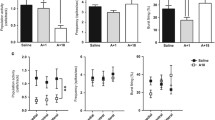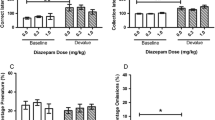Abstract
A test of attentional switching was devised for the rat in which it obtained sucrose reinforcement by an appropriate nose-poke response that discriminated which of two visual events terminated first, in a specially designed chamber. The effect of mesolimbic dopamine depletion (to 20% of control values) produced by infusions of 6-hydroxy-dopamine (6-OHDA) into the nucleus accumbens (N. Acc) on stable discrimination was measured alone and in the presence of a range of doses of d-amphetamine (0.4–2.3 mg/kg IP). The 6-OHDA lesion of the N. Acc impaired post-operative performance transiently by reducing choice accuracy and slowing response latency. By post-operative days 12–16, however, performance recovered to control levels and was not differentially affected by a mainpulation of task difficulty. d-Amphetamine produced dose-dependent performance impairments, which were antagonised by the 6-OHDA treatment. In a second group of N. Acc lesioned rats, the neuroleptic alpha-flupenthixol (0.1–1.0 mg/kg) led to fewer trials being completed and longer latencies than in the sham-operated control group. The results are discussed in terms of the possible attentional mechanisms underlying the d-amphetamine-induced disruption of performance mediated by the N. Acc and of the implications for psychopathology resulting from possible dysfunction of this region.
Similar content being viewed by others
References
Allan LG (1978) The attention switching model: implication for research in schizophrenia. In: Wynne LC, Cromwell RL, Matthysse S (eds) The nature of schizophrenia: New approaches to research and treatment. Wiley, New York, pp 254–261
Creese I, Iversen SD (1975) The pharmacological and anatomical substrates of the amphetamine response in the rat. Brain Res 83:242–248
Evenden JL, Robbins TW (1983) Increased switching, perseveration and perseverative switching following d-amphetamine in the rat. Psychopharmacology 80:67–73
Everitt BJ, Robbins TW, Gaskin M, Fray P (1983) The effects of lesions to ascending noradrenergic neurons on discrimination learning and performance in the rat. Neuroscience 10:397–410
Hoebel BG, Monaco AP, Hernandez L, Aulisi EF, Stanley BG, Lenard L (1983) Self-injection of amphetamine directly into the brain. Psychopharmacology 81:158–163
Iversen SD, Koob GF (1977) Behavioral implications of dopaminergic neurones in the mesolimbic system. In Costa E, Gessa GL (eds) Adv Biochem Psychopharmacology 16: Raven Press, New York, pp 209–214
Iversen LL (1985) Mechanism of action of antipsychotic drugs: retrospect and prospect. In Iversen SD (ed) Psychopharmacology: recent advances and future prospects. Oxford University Press, Oxford, pp 204–215
Kelly PH, Seviour PW, Iversen SD (1975) Amphetamine and apomorphine responses in the rat following 6-OHDA lesions of the nucleus accumbens septi and corpus striatum. Brain Res 94:507–522
Kesner RP, Bierley RA, Pebbles P (1981) Short term memory: the role of d-amphetamine. Pharmacol Biochem Behav 15:673–676
Koek W, Slangen JL (1983) Effects of d-amphetamine and morphine on discrimination: signal detection analysis and assessment of response repetition in the performance deficts. Psychopharmacology 80:125–128
Koob GF, Riley SJ, Smith SC, Robbins TW (1978) Effects of 6-hydroxydopamine lesions of the nucleus accumbens septi and olfactory tubercle on feeding, locomotor activity and amphetamine anorexia in the rat. J Comp Physiol Psychol 92:917–927
Kristofferson AB (1967) Attention and psychological time. Acta Psychologica 27:93–100
Ksir C, Slifer B (1982) Drug effect on discrimination performance at two levels of stimulus control: Psychopharmacology 76:286–290
Lyness WH, Friedle NM, Moore KE (1979) Destruction of dopaminergic nerve terminals in nucleus accumbens: effect on d-amphetamine self-administration. Pharmacol Biochem Behav 11:553–556
Lyon M, Robbins TW (1975) The action of central nervous system stimulant drugs: A general theory concerning amphetamine effects. Curr Dev Psychopharmacology 2:79–163
Mefford I (1981) Application of high performance liquid chromatography with electrochemical detection to neurochemical analysis; measurement of catecholamines, serotonin and metabolites in the rat brain. J Neurochem Meth 3:207–224
Milner B (1982) Some cognitive effects of frontal lobe lesions in man. Phil Trans R Soc Lond B298:211–226
Neale JM, Cromwell RL (1970) Attention and schizophrenia. Prog Exp Pers Res 5:37–66
Norman DA, Shallice T (1980) Attention to action: willed and automatic control of behavior. Center for Human Information Processing. Technical Report No. 99 University of California, San Diego
Pellegrino LJ, Pellegrino AS, Cushman AJ (1979) A stereotaxic atlas of the rat brain. 2nd edition. Plenum Press, New York
Pijnenburg AJJ, Honig WMM, Van der Heyden JAM, Van Rossum JM (1976) Effects of chemical stimulation of the mesolimbic dopamine system on locomotor activity. Eur J Pharmacol 35:45–58
Robbins TW, Everitt BJ (1982) Functional studies of the central catecholamines. Int Rev Neurobiol 23:303–365
Robbins TW, Roberts DCS, Koob GF (1983) Effects of d-amphetamine and apomorphine upon behaviour and schedule-induced licking in rats with 6-hydroxydopamine-induced lesions of the nucleus accumbens. J Pharmacol Exp Ther 222:662–673
Sagar H, Sullivan EV, Cohen NJ, Gabrieli JDE, Corkin S, Growdon J (1985) Specific cognitive deficit in Parkinson's disease. J Clin Exp Neuropsychol 7:158
Spyraki C, Fibiger HC, Phillips AG (1982) Dopaminergic substrates of amphetamine-induced place conditioning. Brain Res 253:185–193
Taylor JR, Robbins TW (1984) Enhanced behavioral control by conditioned reinforcers following microinjections of d-amphetamine into the nucleus accumbens. Psychopharmacology 84:405–412
Weight ML, Ridley RM, Baker HF (1980) The effect of amphetamine on delayed response performance in the monkey. Pharmacol Biochem Behav 12:861–864
Author information
Authors and Affiliations
Additional information
Visiting from the Dept. of Psychology, U. of Wyoming, Laramie, Wy. USA
Visiting from the Mario Negri Institute, Milan, Italy
Rights and permissions
About this article
Cite this article
Robbins, T.W., Evenden, J.L., Ksir, C. et al. The effects of d-amphetamine, alpha-flupenthixol, and mesolimbic dopamine depletion on a test of attentional switching in the rat. Psychopharmacology 90, 72–78 (1986). https://doi.org/10.1007/BF00172874
Received:
Revised:
Issue Date:
DOI: https://doi.org/10.1007/BF00172874




